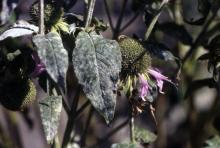Cause The conidial stage of the fungus Neoerysiphe galeopsidis (formerly Erysiphe cichoracearum) has been found in Oregon. Golovinomyces biocellatus has also been reported on this host. The cultivars Cambridge Scarlet and Croftway Pink are reported very susceptible in many areas.
Symptoms White powdery growth on leaves, stems, and sepals. Infected leaves may yellow and fall leaving the lower stems bare of leaves. Plants may become stunted and of poor vigor.
Cultural control
- Remove and destroy infected plant parts or debris.
- Space plants for good air circulation.
- Plant resistant cultivars such as Marshalls Delight or Jacob Cline.
Chemical control Fungicides will do best when used before symptoms develop. Few materials have good eradicant activity. Use at 7- to 14-day intervals; using shorter intervals when environmental conditions favor disease development. Alternate or tank-mix products from different groups that have different modes of action. Limit the use of any one group during crop production.
- Avelyo at 3 to 5 fl oz/100 gal water. Group 3 fungicide. 12-hr reentry.
- Bicarbonate-based products. Might supplement a normal program when powdery mildew is first observed. Do not mix with acidifying agents. Thorough coverage is essential. O
- MilStop (85% potassium bicarbonate) at 2.5 to 5 lb/A in the field or 1.25 to 5 lb/100 gal water in the greenhouse. Oregon and Washington only. 1-hr reentry.
- Monterey Bi-Carb Old Fashioned Fungicide at 4 teaspoons/2 gal water. H
- Compass 50 WDG at 1 to 2 oz/100 gal water. Do not use organosilicate additives. Group 11 fungicide. 12-hr reentry.
- Disarm 480 SC at 1 to 4 fl oz/100 gal water. Group 11 fungicide. 12-hr reentry.
- Fame SC at 1 to 4 fl oz/100 gal water. Group 11 fungicide. 12-hr reentry.
- According to IR-4 data, Heritage is safe on some species of this genus. Use at 1 to 4 oz/100 gal water plus a non-silicone-based wetter sticker on a few plants first before wide spread use. Group 11 fungicide. 4-hr reentry.
- Insignia at SC 3 to 6 fl oz/100 gal water. Do not use with organosilicate-based adjuvants. Use preventively only. Group 11 fungicide. 12-hr reentry.
- Mural at 4 to 7 oz/100 gal water. Group 7 + 11 fungicide. 12-hr reentry.
- Pageant at 6 to 12 oz/100 gal water. Do not use with organosilicone-based adjuvants. Group 7 + 11 fungicide. 12-hr reentry.
- Pipron at 4 to 8 fl oz/100 gal water. Greenhouse production only. Group 5 fungicide. 12-hr reentry.
- Propiconazole-based products. Group 3 fungicides.
- Banner MAXX at 5 to 8 fl oz/100 gal water. 12-hr reentry.
- Seido at 4 to 5 fl oz/100 gal water plus an adjuvant. Group 50 fungicide. 4-hr reentry.
Note: Although not specifically registered for Bee Balm, myclobutanil (Eagle) and triadimefon (Strike) are safe on this crop, according to IR-4 data. These materials provide good control of powdery mildew on many other crops.
Biological control
- Cease or Rhapsody (Bacillus subtilis strain QST 713) at 2 to 8 quarts/100 gal water. Active ingredient is a small protein. Efficacy in the Pacific Northwest is unknown. 4-hr reentry. O
Reference Davidson, C.G. 2007. Monarda, Bee Balm. Chapter 28. In N.O. Anderson (ed.). Flower Breeding and Genetics, 757-779.

